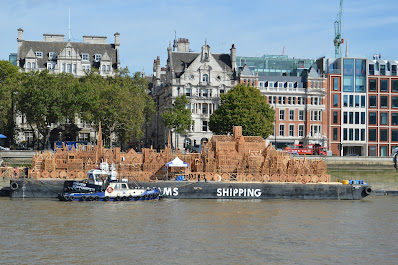As I ponder the devastating effects of Covid 19 on the lives of millions of people, and also how the great quakes of 2010 and 2011 changed Christchurch, NZ, forever, I'm reminded of another time when disaster changed forever the city of London: The Great Fire of 1666. The inferno began in the king's baker's shop in Pudding Lane and quickly spread to destroy 80% of the walled city. London dated from Roman times and was a bustling, congested city full of timber houses.
 The timber houses were tightly packed together and thatched, waterproofed with tar - highly flammable. THe city was also filled with sheds packed with hay and straw. The fire continued at least 5 days. Originally the mayor didn't want to destroy a lot of houses because of the cost of rebuilding. Eventually, days later, the city had to resort to blowing up buildings to create fire breaks. It is estimated that 70,000 of th 80,000 residents were rendered homeless, with a bitter winter ahead.
The timber houses were tightly packed together and thatched, waterproofed with tar - highly flammable. THe city was also filled with sheds packed with hay and straw. The fire continued at least 5 days. Originally the mayor didn't want to destroy a lot of houses because of the cost of rebuilding. Eventually, days later, the city had to resort to blowing up buildings to create fire breaks. It is estimated that 70,000 of th 80,000 residents were rendered homeless, with a bitter winter ahead. Among the buildings lost was Old St Paul's. Rather similar to the inferno which partially destroyed the cathedral of Notre Dame in Paris in 2019, scaffolding erected around St Paul's cathedral at the time added to the inferno and molten lead from the roof flowed through the streets. The masonry is reported to have exploded like grenades.
Among the buildings lost was Old St Paul's. Rather similar to the inferno which partially destroyed the cathedral of Notre Dame in Paris in 2019, scaffolding erected around St Paul's cathedral at the time added to the inferno and molten lead from the roof flowed through the streets. The masonry is reported to have exploded like grenades. Sir Christopher Wren designed the new city, including a new St Paul's with its iconic dome. It took decades to rebuild the city. Houses now had to be faced in brick, streets were widened, pavements a sewers were laid making London much cleaner. The fire had also greatly diminished the population of rats carrying the plague.In 2016 I visited London and my visit coincided with the 350th anniversary of the Great Fire. Moored in the River Thames was a 120m replica of the
Sir Christopher Wren designed the new city, including a new St Paul's with its iconic dome. It took decades to rebuild the city. Houses now had to be faced in brick, streets were widened, pavements a sewers were laid making London much cleaner. The fire had also greatly diminished the population of rats carrying the plague.In 2016 I visited London and my visit coincided with the 350th anniversary of the Great Fire. Moored in the River Thames was a 120m replica of the  skyline of old lost London. The replica was built by 'burn artist' David Best and positioned so that a repeat of the original fire could not wipe out 20th century London.I joined thousands of residents and tourists to watch the official burning of the replica, remembering the tragic events of 1666 which had been a tragedy and an economic disaster. The birning started really slowly and clearly had several ignition points. What is this fascination we humans have for watching fiery destruction? The spectators were solemn and mesmerised as we watched the spectacle creeping further and higher along the barge. At their height, the flames were three stories high. Helicopters whirred overhead.
skyline of old lost London. The replica was built by 'burn artist' David Best and positioned so that a repeat of the original fire could not wipe out 20th century London.I joined thousands of residents and tourists to watch the official burning of the replica, remembering the tragic events of 1666 which had been a tragedy and an economic disaster. The birning started really slowly and clearly had several ignition points. What is this fascination we humans have for watching fiery destruction? The spectators were solemn and mesmerised as we watched the spectacle creeping further and higher along the barge. At their height, the flames were three stories high. Helicopters whirred overhead.Accompanying the barge, the dome of St Paul's was lit with a firey scenography, reminding us all of the horror of the immolation of the old St Paul's. Paris and other great cities have happily retained much of their 2000-year-old monuments and buildings. London lost much but the Thames meant the other bank of the city (less commercially developed) survived and could ferry supplies and help. I was very glad I had the good fortunate to be in the right place at the right time to see this event. If I had been there 350 years ago how differently I would have felt.
You can watch a fascinating, detailed video on the 2016 project, the 1666 fire , myth-busting and great historical info on this link https://www.youtube.com/watch?v=o47qgPvXAyU















0 comments:
Post a Comment
I welcome your comments, contributions and feedback.